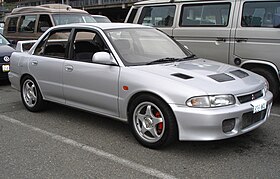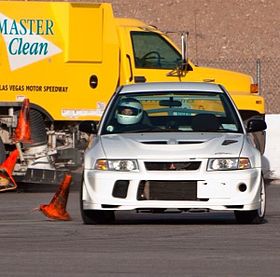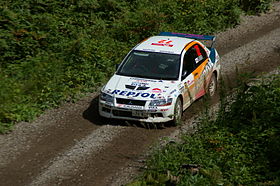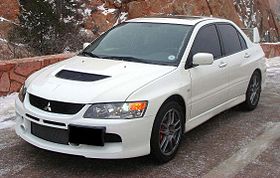Mitsubishi Lancer Evolution
| Mitsubishi Lancer Evolution | |
|---|---|
 | |
| Overview | |
| Manufacturer | Mitsubishi |
| Also called | Mitsubishi Evolution / Lancer Evo / Evo |
| Production | 1992–present |
| Assembly | Okazaki, Aichi (Nagoya Plant) |
| Body and chassis | |
| Class | Sport compact Sports sedan |
| Body style | 4-door sedan 5-door station wagon (2006-2007) |
| Layout | Front engine, 4 wheel drive |
| Related | Mitsubishi Lancer Mitsubishi Lancer WRC Mitsubishi Racing Lancer |
| Powertrain | |
| Engine | 2.0 L I4 turbo 4G63T (1992–2007) 4B11T (2008–present) |
| Transmission | 6-speed TC-SST (2008-present) 5-speed automatic (2002, 2006-2007) 5-speed manual (1992-present) 6-speed manual (2003-2006) |
The Mitsubishi Lancer Evolution, also known as the Lancer Evo, Lan Evo, or just Evo,[1] is a high performancesports sedan manufactured by Mitsubishi Motors that is based on the normal Lancer. There have been ten official versions to date, and the designation of each model is most commonly a Roman numeral. All use two litre,turbocharged engines and all-wheel drive systems.[2]
The Evolution was originally intended only for Japanese markets, but demand on the "grey import" market led the Evolution series to be offered through Ralliart dealer networks in the United Kingdom and in various European markets from around 1998. Mitsubishi decided to export the eighth generation Evolution to the United States in 2003 after witnessing the success Subaru had in that market with their long-time direct rival, the Subaru Impreza WRX STi.[3]
Japanese-spec cars were limited by a gentlemen's agreement to advertise no more than 280 PS (206 kW; 276 hp), a mark already reached by Evolution IV. Therefore, each subsequent version has unofficially evolved above the advertised power figures, with the Japanese-spec Evolution IX reaching an alleged output of around 321 PS (236 kW; 317 hp). Various versions available in other markets, particularly the UK, have official power outputs up to 446 PS (328 kW; 440 hp).
The tenth and final generation of the Lancer Evolution was launched in Japan 2007, and overseas markets in 2008.
Evolution I
| First generation | |
|---|---|
 | |
| Overview | |
| Production | October 1992 – January 1994 |
| Body and chassis | |
| Platform | CD9A |
| Powertrain | |
| Engine | 4G63T |
| Transmission | 5-speed manual |
| Dimensions | |
| Wheelbase | 2,500 mm (98.4 in) |
| Length | 4,310 mm (169.7 in) |
| Width | 1,695 mm (66.7 in) |
| Height | 1,395 mm (54.9 in) |
| Curb weight | 1,170–1,240 kg (2,579–2,734 lb) |
The first Lancer Evolution used the 2.0 L turbocharged DOHC engine and AWD drivetrain from the original Galant VR-4 in a Lancer chassis, and was sold in GSR and RS models. This engine was also used in the Mitsubishi RVRwith the Hyper Sports Gear trim package, and the Mitsubishi Chariot Resort Runner GT. The RS was a stripped-down version that lacked (power) windows and seats, anti-lock brakes, a rear wiper, and had steel wheels to weigh approximately 70 kg (154 lb) less than the 1,238 kg (2,729 lb) GSR, ready for racing or tuning. The RS version was released with a mechanical plate type rear Limited-slip differential (LSD). The GSR came with all of the conveniences of a typical street car, including a digital screen climate control system. It came with Mitsubishi's 4G63engine producing 247 PS (182 kW; 244 hp) at 6000 rpm and 309 N·m (228 lb·ft) at 3000 rpm. 5,000 of the first generation Evolutions were sold between 1992 and 1993. Top speed was 228 km/hour (142 mph). The GSR version of the Evolution I was the only Evolution Lancer released with a Viscous Limited Slip Rear Differential (VLSD). The subsequent Evolution Lancer models all featured rear mechanical plate type LSD's.
Evolution II
| Second Generation | |
|---|---|
| Overview | |
| Production | January 1994 – February 1995 |
| Body and chassis | |
| Platform | CE9A |
| Powertrain | |
| Transmission | 5-speed manual |
| Dimensions | |
| Wheelbase | 2,510 mm (98.8 in) |
| Length | 4,310 mm (169.7 in) |
| Width | 1,695 mm (66.7 in) |
| Height | 1,420 mm (55.9 in) |
| Curb weight | 1,180–1,250 kg (2,601–2,756 lb) |
The Evolution II was upgraded in December 1993, and was produced until February 1995. It consisted mainly of handling improvements, including minor wheelbase adjustments, lighter front swaybar that connected via swaybar links to the front struts, bodywork tweaks including a larger spoiler, and tires that were 10 mm (0.4 in) wider. This Evolution also has a 50 l (13.2 US gal; 11.0 imp gal) fuel tank. Power output was increased to 256 PS (188 kW; 252 hp) from the same engine and torque was unchanged for both GSR and RS models.
Evolution III
| Third generation | |
|---|---|
| Overview | |
| Production | February 1995 – August 1996 |
| Body and chassis | |
| Platform | CE9A |
| Powertrain | |
| Transmission | 5-speed manual |
| Dimensions | |
| Wheelbase | 2,510 mm (98.8 in) |
| Length | 4,310 mm (169.7 in) |
| Width | 1,695 mm (66.7 in) |
| Height | 1,420 mm (55.9 in) |
| Curb weight | 1,190–1,260 kg (2,624–2,778 lb) |
February 1995 saw the arrival of the Evolution 3, which had several improvements over the previous models. New, more aggressive styling and a new nose moulding improved the air supply to the radiator, intercooler and brakes. New side skirts and rear bumper moldings and a larger rear spoiler were added to reduce lift. Improved engine had higher compression ratio than before,[4] and new turbocharger compressor (60 mm to 68 mm[5]), which gave power output of 270 bhp (201 kW) at 6250 rpm, 309 N·m (228 lb·ft) at 3000 rpm.
Evolution IV
| Fourth generation | |
|---|---|
 | |
| Overview | |
| Production | August 1996 – January 1998 |
| Body and chassis | |
| Platform | CN9A |
| Powertrain | |
| Transmission | 5-speed manual |
| Dimensions | |
| Wheelbase | 2,510 mm (98.8 in) |
| Length | 4,330 mm (170.5 in) |
| Width | 1,690 mm (66.5 in) |
| Height | 1,415 mm (55.7 in) |
| Curb weight | 1,260–1,350 kg (2,778–2,976 lb) |
The Lancer platform was completely changed in 1996, and along with it, the Evolution, which had become extremely popular throughout the world. The engine and transaxle was rotated 180° to better balance the weight and eliminatetorque steer. There were two versions available, The RS and GSR. The RS version was produced as a competition car with a limited-slip front differential and a friction type LSD at the rear. It also came with GLX seats and a choice of either 16" or 17" OZ light weight racing wheels. The RS also had wind up windows, optional air conditioning in some models, and a few extra brace bars to strengthen the chassis, one behind the front grill and the other across the boot floor. The RS also had thinner body panels and glass. The GSR and the RS shared a new twin scroll turbocharger which helped to improve response and increase power to 280 PS (206 kW; 276 hp) at 6,500 rpm and 330 N·m (243 lb·ft) and torque at 4,000 rpm. Mitsubishi's new Active Yaw Control appeared as a factory option on the GSR model, which used steering, throttle input sensors and g sensors to computer-hydraulically control torque split individually to the rear wheels and as a result the 10000 Evolution IVs produced all sold quickly. The Evolution IV can be distinguished by its two large fog lights in the front bumper (option on RS version), and the newly designed tail lights on the rear, which became a standard design to Evolution V, which would become yet another trademark of the Evolution series. This new generation was slightly heavier than previous Evos—the GSR in particular due to the added technology systems—but to counter this the car produced even more power—the weight of the RS being 1,260 kg (2,778 lb) and the GSR being 1,345 kg (2,965 lb). Much of the technical improvements for this generation were also used in the second generation Mitsubishi RVR sold only in Japan.
Evolution V
| Fifth Generation | |
|---|---|
 | |
| Overview | |
| Production | January 1998 - January 1999 |
| Body and chassis | |
| Platform | CP9A |
| Powertrain | |
| Transmission | 5-speed manual |
| Dimensions | |
| Wheelbase | 2,510 mm (98.8 in) |
| Length | 4,350 mm (171.3 in) |
| Width | 1,770 mm (69.7 in) |
| Height | 1,405–1,415 mm (55.3–55.7 in) |
| Curb weight | 1,260–1,360 kg (2,778–2,998 lb) |
Many aspects of the car were changed such as:
- The interior was upgraded in the GSR version with a better class of Recaro seat.
- The body kit had flared arches at the front and rear and a new aluminium rear spoiler replaced the IV FRP version and gave an adjustable angle of attack to alter rear down force.
- The track was widened by 10 mm (0.4 in), the wheel offset changed from ET45 to ET38 along with the wheel diameter which rose from 16" to 17" to accommodate Brembo brakes which were added to enhance braking.
- In addition the brake master cylinder bore increased by 0.3 millimetres (0.01 in).
- The engine was strengthened in a few areas and the cam duration was increased. The pistons were lighter with a smaller skirt area. 510 cc injectors were replaced with 560 cc injectors for better engine reliability due to more electrical "headroom" and the ECU was changed to include a flash ROM, allowing more boost pressure to the same TD05-HR as the Mitsubishi Evolution IV.
Furthermore, the turbocharger was again improved. Torque was increased to 373 N·m (275 lb·ft) at 3000 rpm. Power officially stayed the same, at 280 PS (206 kW; 276 hp), though some claim horsepower was actually somewhat higher.
Evolution VI
| Sixth generation | |
|---|---|
 | |
| Overview | |
| Production | January 1999 – March 2001 |
| Body and chassis | |
| Platform | CP9A |
| Powertrain | |
| Transmission | 5-speed manual |
| Dimensions | |
| Wheelbase | 2,510 mm (98.8 in) |
| Length | 4,350 mm (171.3 in) |
| Width | 1,770 mm (69.7 in) |
| Height | 1,405–1,415 mm (55.3–55.7 in) |
| Curb weight | 1,260–1,360 kg (2,778–2,998 lb) |
The Evolution VI's changes mainly focused on cooling and engine durability. It received a larger intercooler, larger oil cooler, and new pistons, along with a titanium-aluminide turbine wheel for the RS model, which was a first in a production car. The Evolution VI received new bodywork yet again, with the most easily noticeable change being within the front bumper where the huge fog lights were reduced in size and moved to the corners for better airflow. A new model was added to the GSR and RS lineup; known as the RS2, it was an RS with a few of the GSR's options. Another limited-edition RS was known as the RS Sprint, an RS tuned by Ralliart in the UK to be lighter and more powerful with 330 hp (246 kW).
Evolution VII
| Seventh generation | |
|---|---|
 | |
| Overview | |
| Production | March 2001 – January 2003 |
| Body and chassis | |
| Platform | CT9A |
| Powertrain | |
| Transmission | 5-speed manual 5-speed automatic |
| Dimensions | |
| Wheelbase | 2,625 mm (103.3 in) |
| Length | 4,455 mm (175.4 in) |
| Width | 1,770 mm (69.7 in) |
| Height | 1,450 mm (57.1 in) |
| Curb weight | 1,310–1,400 kg (2,888–3,086 lb) |
In 2001, Mitsubishi was forced by the FIA to race in the WRC using WRC rules for building a car instead of the Group A class rules, and thus did not need to follow homologation rules. The Evolution VII was based on the larger Lancer Cedia platform and as a result gained more weight over the Evolution VI, but Mitsubishi made up for this with multiple important chassis tweaks. The biggest change was the addition of an active center differential and a more effective limited-slip differential, while a front helical limited-slip differential was added. Torque was increased again to 385 N·m (284 lb·ft) with engine tweaks that allowed greater airflow, and horsepower officially remained at 280 PS (206 kW; 276 hp).
The introduction of the Evolution VII also marked the first time an automatic drivetrain was included within the model lineup—the GT-A. Seen as the 'gentleman's express' version of the visually similar VII GSR and the RS2, the GT-A model was only produced in 2002 and had the following distinguishing interior and exterior specification: GT-A-only diamond cut finish 17-inch (430 mm) alloy wheels, clear rear light lenses and all-in-one style front headlights (later used on the Evolution VIII). The GT-A had the option of either no spoiler, the short spoiler (as per the Lancer Cedia; and later used on the Evolution VIII 260) or the thunderspoiler as used on the standard Evolution VII models. The most distinguishing feature was a smooth bonnet with no air-grills on it at all and the revised front bumper. Although offering inferior cooling capabilities, the bonnet was designed to give a cleaner line through the air with less air resistance at motorway speeds.
Evolution VIII
| Eighth generation | |
|---|---|
 | |
| Overview | |
| Production | January 2003 – March 2005 |
| Body and chassis | |
| Platform | CT9A |
| Powertrain | |
| Transmission | 5-speed manual 6-speed manual |
| Dimensions | |
| Wheelbase | 2,625 mm (103.3 in) |
| Length | 4,490–4,535 mm (176.8–178.5 in) |
| Width | 1,770 mm (69.7 in) |
| Height | 1,450 mm (57.1 in) |
| Curb weight | 1,320–1,410 kg (2,910–3,109 lb) |
The Mitsubishi Lancer Evolution VIII was modified again in 2003 this time sporting 17" grey Enkei wheels, BremboBrakes and Bilstein shocks to handle traction and a 5-speed manual gearbox with 280 PS (202 kW; 276 hp)(approx. 234 hp to the wheels). Originally a one off model, sales were so successful in the U.S. that by 2005 it was available in four trims: the standard GSR model in Japan, the RS, 5-speed gearbox, and standard wheels (lacking excess components, such as interior map lights, power windows/doors, and radio), the SSL (with a sunroof, trunk mounted subwoofer, and leather seats), and the MR, which came with a revised limited-slip front differential, aluminum MR shift knob, handbrake with carbon fiber handle, 17 inch BBS wheels, aluminum roof, and a 6-speed manual gearbox. The new Evolution also sported chrome housing tail lights and head lights.
The Mitsubishi Lancer Evolution VIII MR uses slick-response Bilstein shocks for improved handling. The aluminium roof panel and other reductions in body weight have lowered the centre of gravity to produce more natural roll characteristics. Detail improvements have also been made to Mitsubishi's own electronic four-wheel drive, to the ACD 5 + Super AYC 6 traction control, and to the Sports ABS systems. The Lancer Evolution VIII displayed at the 2003 Tokyo Motor Show took the MR designation traditionally reserved for Mitsubishi Motors high-performance models (first used for the Galant GTO). Other parts on the MR include BBS alloy wheels, the aforementioned Bilsteinshocks, and an aluminium roof. In the United Kingdom, many special Evolutions were introduced, including the FQ300, FQ320, FQ340, and FQ400 variants. They came with 305, 325, 345, and 405 hp (227, 239, 254 and 302 kW), respectively.[6][7][8]
| Model year | Model | Type | Frontal driver rating | Frontal passenger rating | Side driver rating | Side passenger rating | 4x2 Rollover |
|---|---|---|---|---|---|---|---|
| 2004 | Lancer Evolution | 4-DR | N/A | N/A | N/A |
Evolution IX
| Ninth generation | |
|---|---|
 | |
| Overview | |
| Production | March 2005 – October 2007(August 2006-Late 2008 MR) |
| Body and chassis | |
| Platform | CT9A CT9W |
| Powertrain | |
| Transmission | 5-speed manual 6-speed manual 5-Speed Automatic (wagon) |
| Dimensions | |
| Wheelbase | 2,625 mm (103.3 in) |
| Length | 4,490 mm (176.8 in) |
| Width | 1,770 mm (69.7 in) |
| Height | 1,450 mm (57.1 in) |
| Curb weight | 1,310–1,490 kg (2,888–3,285 lb) |
Mitsubishi introduced the Lancer Evolution IX in Japan on March 3, 2005,[14] and exhibited the car at the Geneva Motor Show for the European market the same day.[15] The North American markets saw the model exhibited at theNew York International Auto Show the following month.[16] The 2.0 L 4G63 engine has MIVEC technology (variable valve timing), and a revised turbocharger design boosting official power output at the crankshaft to 291 PS (214 kW; 287 hp) and torque to 392 N·m (289 lb·ft).
The USDM Lancer Evolution IX models: standard (Grand Sport Rally or "GSR" in some markets), RS (Rally Sport), SE (Special Edition) and MR (Mitsubishi Racing) varied slightly in their performance capabilities. Subtleties unique to each model accounted for variations in acceleration, handling and top speed. The RS excluded features standard on the standard, SE and MR models (stereo system, power windows and locks, rear wiper, rear wing, trunk lining and sound insulation). The result is a weight savings of over 60 lb (27 kg). The fuel capacity remains the same as the Evo VIII at 14 U.S. gal (53 L).
Although the RS is the lightest of the group, the RS did not manage to outperform the standard IX and the MR around a road course (even if only by fractions of a second). This was purported to be due to the lack of a rear wing on the RS. In a drag race, the three models are all about even. They are all capable of 0-60 times between 4.2-4.5 seconds, and can run quarter mile times ranging from 12.6 to 13.3 (12.7-13.0 USA versions) seconds depending on the model/driver. The RS model was produced for rally and racing teams who wanted a platform to build a race car from. It is stripped of all the creature comforts, and other upgrades that drive the price up for features that the race teams would not require.
The IX MR retained the features of the Evolution VIII MR, like Bilstein shocks, a 6-speed manual transmission, a rooftop vortex generator, BBS forged wheels, HID xenon headlights, foglights, accessory gauge package, "zero lift" kit, special badging and an aluminum roof. All models continued to sport Recaro bucket seats, Brembo brakes andMomo steering wheels. Additional revisions from 2005 included a closer gear ratio for the 5-speed manual transmission, new lighter Enkei wheels on non-MR models, a redesigned front end with a more efficient air dam (the most noticeable feature are the two small oval ducts to cool the intercooler pipes), and a new rear bumper with a diffuser undersurface to smooth out the airflow coming out of the car for non-US models. In an effort to reduce the price increase on the Evolution IX model,[citation needed] HID headlights were no longer standard equipment on the base IX (nor were they standard on the 2005 VIII), and were available only in the SSL package (Sun, Sound, and Leather), SE (Special Edition) and MR trims.
The US versions of the Lancer Evolution IX did not come with the AYC but the ACD was still present. The drivers can select from three different driving modes, "Tarmac" "Gravel" and "Snow", and the car's computer system relatively promotes the active center differential to change the differential locking which, Despite popular belief, this switch DOES NOT change the torque split. The differential is geared at 50:50 and cannot be changed by the push of a button. What this switch actually does is quite simple. Each setting determines how long the ACD will delay in freeing the center differential after a steering input is made. In addition, it will determine how much locking force the ACD will exhibit on the clutch pack and center differential.
Evolution X
| Tenth Generation | |
|---|---|
 | |
| Overview | |
| Production | October 2007–2015 |
| Body and chassis | |
| Platform | CZ4A |
| Powertrain | |
| Engine | 2.0L 4B11T |
| Transmission | 6-speed twin-clutch transmission 5-speed manual |
| Dimensions | |
| Wheelbase | 2,650 mm (104 in) |
| Length | 4,570 mm (180 in) |
| Width | 1,810 mm (71 in) |
| Height | 1,480 mm (58 in) |
| Curb weight | 1,420–1,600 kg (3,131–3,527 lb) |
In 2005, Mitsubishi introduced a concept version of the next-gen Evolution at the 39th Tokyo Motor Show named theConcept-X,[18] designed by Omer Halilhodžić at the company's European design centre.[19]
Mitsubishi unveiled a second concept car, the Prototype-X, at the 2007 North American International Auto Show(NAIAS).[20]
The Lancer Evolution X sedan features a newly designed 4B11T 2.0L (1998cc) turbocharged, all-aluminium inline-4GEMA engine. Power and torque depend on the market but all versions will have at least 280 PS (206 kW; 276 hp). (JDM version), the American market version will have slightly more. The UK models will be reworked by Mitsubishi UK, in accordance with previous MR Evolutions bearing the FQ badge. Options for the UK Evolutions are expected to be between 300 hp (220 kW) and 360 hp (270 kW).
Two versions of the car are offered in the U.S. The Lancer Evolution MR, with 6-speed Twin Clutch Sportronic Shift Transmission (TC-SST). The other version is the GSR which has a 5-speed manual transmission system. The car also has a new full-time four-wheel drive system named S-AWC (Super All Wheel Control), an advanced version of Mitsubishi's AWC system used in previous generations.[21] The S-AWC uses torque vectoring technology to send different amounts of torque to the rear wheels.
It also features Mitsubishi's new sequential semi-automatic six speed SST twin-clutch transmission with steering-mounted magnesium alloy shift paddles. It has replaced the Tiptronic automatic transmission, hence the SST version replaced the GT-A version (which was used in Evolution VII and Evolution IX Wagon). A five speed manual gearbox will also be available. The new Lancer Evolution will also incorporate Mitsubishi's next generation RISE safety body.
The Evolution X went on sale October 1, 2007 in Japan,[22] January 2008 in the USA,[23] February in Canada (as the first version of Evolution in Canada)[24] and in March 2008 in the UK.[25] The Twin Clutch SST version was available in Japan from November 2007.[26] Europe will follow with sales in May, GSR and MR version included premium Package. The introduction of the 2010 MR-Touring moved the car even further upscale. Leather and a Moonroof became standard while revising the rear spoiler to just a lip spoiler.

No comments:
Post a Comment